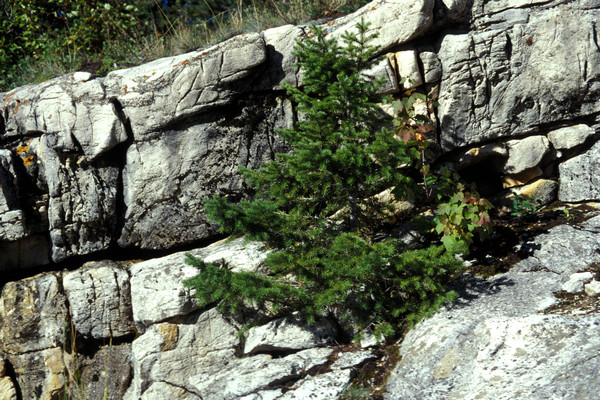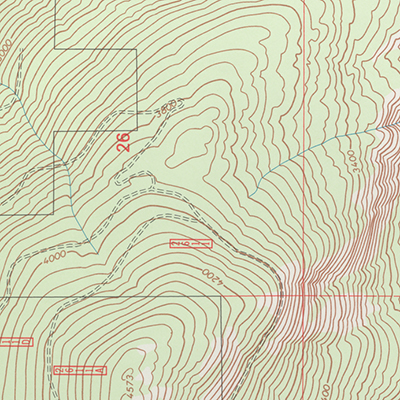Learn
There are five major factors that influence soil formation:
- Weathering of parent material -physical, chemical, and biological weathering
- Climate
- Living organisms - the type of plant life present
- Topography - altitude / landscape position
- Time
- Physical Weathering
- Chemical Weathering
- Biological Weathering
- Climate & Plant Life
- Topography
- Time
- Soil Horizons

Physical Weathering
At one time or another, all soil formation began from bare rock - bedrock. This bedrock is the source of parent material that begins soil formation. Bedrock is broken down through the process of weathering. Weathering is a set of physical, chemical, and biological processes that break down the bedrock into inorganic material that eventually becomes parent material for the soil.
Physical weathering involves the weakening and breaking down of rock by physical forces, such as
- temperature fluctuation,
- abrasion,
- frost action, and
- salt crystal growth.
Abrasion occurs when the exposed surface of a rock is broken down by continual friction from water, wind, and ice. These sources of weathering can carry sand and smaller rock particles. These particles collide with other rock material causing them to be broken or worn down. Moving water, wind, and ice (glaciers) are also responsible for deposition the accumulation of broken down parent material and soil .

Wind is the primary cause for these once intrusive (beneath the surface) magma rocks being exposed.
Another type of physical weathering is called frost action. This occurs when water enters into cracks of rocks and freezes. When this water freezes, its volume increases by about 10%. This causes the cracks in the rock to enlarge, eventually causing the rock to break apart.
Salt crystal growth, occurs when groundwater enters the empty pores or spaces of rocks. As the water evaporates from the rock, salt crystals grow putting pressure on the rock causing it to break.

Chemical Weathering
Chemical weathering involves the weakening or breaking down of rock through chemical reactions.
- Oxidation - chemicals in rock react with oxygen
- Hydrolysis - minerals in rock react with water
- Carbonation - minerals in rocks react with carbonic acid

Chemically weathered sandstone

Biological Weathering

Biological weathering occurs when rocks are broken down by living organisms through either physical or chemical processes. Plants, animals, and microbes microscopic fungi and bacteria can all play a role in the weathering of rock material. Growing plant roots can exert pressure on rocks, which can weaken them and cause them to break. Some animals burrow in the ground, and when they dig holes, they can break down rocks into smaller pieces. In the image above, weathering has produced cracks in these rocks, allowing a tree to take hold.
Lichens mutualistic relationship of algae and fungi growing on rocks are an example of biological weathering that is chemical. The fungi part of the lichen releases chemicals into the rock that changes the chemical makeup of the rock making it weaker and more susceptible to physical weathering.
The type of parent material broken down influences the physical and chemical characteristics of the soil. The parent material is the main determining factor in the texture, color, and the pH of the soil. Soils often come from more than one type of parent material, which is called polygenetic coming from several sources.

Climate is the major factor in determining soil formation and plant types.
Image citation:
Weathering; roots on rocks Paul Fuqua, 2003. Image. Discovery Education.
Web. 29 June 2015. <http://www.discoveryeducation.com/>.

Climate & Plant Life
Climate is the average weather conditions in an area: yearly average humidity, precipitation, and temperature. It is the major determining factor for soil formation and type. Areas that have higher temperatures and humidity/precipitation tend to form soil faster. While cooler/dryer climates tend to have slower soil formation.
The temperature and water available affect the rate of weathering and decomposition. Decomposition is the breaking down of organic matter dead organisms and the waste products of organisms . Decomposition provides the organic matter that gives nutrients to the soil. Organisms, such as bacteria, fungi, insects, and earthworms are examples of organisms that help breakdown or decompose organic matter.
The climate of an area also determines the type of plant life that exists. The type of plant life in an area affects soil formation as well as what animal life exists in the area. Plants supply organic material to the soil through the shedding of leaves, twigs, and bark. The plant material is decomposed by microscopic fungi, bacteria, insects, and worms to provide nutrients to the soil. The chemical makeup of these materials can influence the pH and nutrient levels of the soil.
Plant roots also help with soil development. Plants with longer root systems create passages for more water movement than shallow rooted plants. This causes soils with longer plant roots to typically be better for growing.

Topography
Topography is another factor that can influence soil formation and quality. Topography is the arrangement of the natural and artificial features of an area. It also shows the contour of the land elevation, elevation change, and how and where the land slopes .
Steepness, shape, and length of the slope of the land are important factors in soil formation. They influence how water flows over the soil and creates areas that are different in moisture. The soils at higher elevations tend to be drier than the soils at lower elevations because the water flows downhill and gathers in low areas. These wetter areas can cause improper root growth.
Topography and land position can also cause the deposition of soil and sediments from areas of higher elevation to areas of lower elevation. This can cause the soil at lower elevations to be different from soils at higher elevations.

A topop map showing elevation, change in elevation, and slope changes. Fullscreen version

Time
Time is the final factor that contributes to soil formation. Soil is not formed over night. It is estimated that it can take over 500-1,000 years for one inch of topsoil to form. How long it takes for soil formation and development depends on environmental factors, especially climate. Soil formation usually occurs more quickly in warmer and wetter climates. This is due to soil forming factors such as decomposition and weathering occurring at a faster rate in these areas.
![]() Watch Humus Formation (6:28) to see a time-lapse video of the formation of humus. Humus is the dark organic material that makes up soil, especially the upper layers of soil such as the topsoil or A Horizon. This video shows how topsoil is formed on parent material with microbes breaking down dead organic matter. Notice how a thin layer of soil is formed over time, and notice the types of organisms involved in the process.
Watch Humus Formation (6:28) to see a time-lapse video of the formation of humus. Humus is the dark organic material that makes up soil, especially the upper layers of soil such as the topsoil or A Horizon. This video shows how topsoil is formed on parent material with microbes breaking down dead organic matter. Notice how a thin layer of soil is formed over time, and notice the types of organisms involved in the process.
 |
 |
